The art and science of better marketing involves using tools, techniques, and metrics to build campaigns based on strong analytical foundations that grow into lasting success.

I believe in BETTER MARKETING, and marketing campaigns are one of the best ways to deliver on that. Campaigns are often undervalued tools for kickstarting new business activities. They don’t require you to start from scratch; instead, they build on elements of what you already have in place, like roots drawing from fertile soil, to generate new momentum. For small businesses and nonprofits, a well-organized marketing campaign can enhance your focus, yield measurable results, and enable you to adjust your strategies in real-time.
When I work with a client who may need a complete marketing makeover, it’s tempting to recommend a full marketing plan and rebranding. While there are situations where that approach is warranted, starting with a more focused marketing campaign is often a better option. A well-defined marketing campaign can serve as proof of concept, demonstrating what effective marketing looks like while generating positive results and laying the groundwork for future growth.
When executed correctly, campaigns extend beyond simple marketing efforts or enterprise-wide branding activities. They target specific objectives — such as boosting sales, increasing donations, or driving web traffic — and they achieve this by maximizing the impact of every dollar spent. Campaigns also build trust and engagement while highlighting what sets your brand apart. And the best part? They create the momentum needed to grow stronger over time.
Running a campaign can feel overwhelming at first, especially if it involves online advertising — which most do. Platforms like Meta Ads and Google Ads provide powerful tools, but their technical interfaces can be confusing and tedious. Many small business owners become frustrated, abandon digital ads too quickly, or assume they don’t work. The truth is that with a clear plan and a focus on the numbers, campaigns can deliver significant results without breaking the bank.
In this guide, we’ll walk you through planning, executing, and measuring a marketing campaign. Since this is a data science blog and I used the word “math” in the title, we won’t shy away from analytics. In fact, a campaign is all about building on a strong analytical foundation, measuring results, and learning what works. Whether you’re launching a 90-day push for a new product or simply testing the waters, you’ll discover practical tips on using data to inform your decisions. But first, let’s define what we mean by a marketing campaign — what it is, how it differs from general marketing efforts, and why it’s an essential tool for business growth.
What is a Marketing Campaign?
A marketing campaign is a focused effort to achieve clear goals in a set timeframe. Unlike ongoing marketing tasks such as social media posts or email newsletters, campaigns zero in on measurable results through targeted actions.
For example:
- A small business might run a campaign to promote a seasonal sale.
- A nonprofit could create a campaign to raise $10,000 in donations during Giving Tuesday.
Campaigns are important because they provide structure and direction. They allow businesses to allocate resources effectively, track performance metrics, and make real-time adjustments. Unlike a marketing plan, which outlines all marketing strategies, goals, and tactics over a longer period, such as a year or more, a marketing campaign typically focuses on the next 90 days with a specific goal.
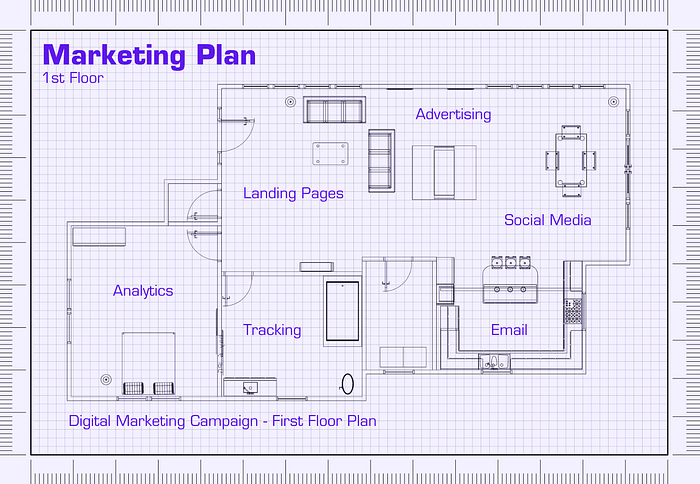
Consider your marketing plan as the blueprint of your house. Each campaign represents an individual floor containing rooms designed for specific purposes. A campaign can revive or refocus existing marketing activities without requiring a complete overhaul, just as you might remodel a single room rather than the entire house. Much like adding a new branch to a growing tree, campaigns build on the structure and foundation already in place, expanding your reach and strengthening your brand.
Why Campaigns Can Feel Overwhelming
Running an efficient campaign requires more than creativity — it demands technical know-how, especially when it comes to online advertising platforms. Platforms like Meta Ads and Google Ads rely heavily on AI optimizations to simplify tasks like bidding and targeting, but they still require users to make critical decisions upfront. Without expertise or proper guidance:
- Choosing the wrong ad objective (e.g., “awareness” instead of “conversions”) can derail your efforts.
- Default settings often prioritize simplicity over effectiveness.
- Poor targeting can waste budgets by showing ads to irrelevant audiences.
This is why many small businesses abandon digital ads prematurely. Online advertising is one of the best ways to bolster a marketing campaign.
Typical Goals for a Marketing Campaign
Every organization has unique goals, but based on my 20+ years of experience, most campaigns fall into these categories:
- Product Companies: Increase sales, launch new products, or clear inventory.
- Service Providers: Attract new clients, retain existing ones, or promote seasonal offers.
- Business-to-Business (B2B) Companies: Generate qualified leads, build partnerships, or establish thought leadership.
- Business-to-Consumer (B2C) Companies: Drive online traffic, grow social media engagement, or boost conversions.
- Nonprofits: Raise awareness, recruit volunteers, or increase donations.
Major Activities in Setting Up a Marketing Campaign
Planning: It’s important to properly plan a campaign in order for it to be successful. Resist the temptation just to throw advertising dollars at a specific channel or think clever social media posts will carry the day.
- Start by identifying your target audience and mapping their customer journey — from awareness to retention. My previous article about sales funnels goes into more detail about this.
- Use SMART goals (Specific, Measurable, Achievable, Relevant, Time-bound) to define success. For instance: “Increase website traffic by 25% over three months.”
- Forecasting plays a key role here. You can predict potential outcomes and set realistic expectations by analyzing historical data from previous campaigns or industry benchmarks (e.g., average conversion rates).
Setup: Most digital marketing campaigns are powered by marketing technology (MarTech) tools such as online advertising systems, social media management software, email services, website landing pages, and tracking systems. Despite companies' efforts to make this simple, it’s been my experience that it’s not, and it changes often! Besides technology, a successful campaign needs to be set up with high-quality creative assets.
- Ensure you or your agency has proper credentials and access to required platforms like Meta Ads or Google Ads.
- Create high-quality visuals that reflect consistent branding (e.g., colors and logos). Recognizable imagery builds trust and helps your ads stand out.
- Avoid over-relying on AI-generated content for words or visuals. While AI tools can speed up brainstorming or production processes, they often lack originality and emotional resonance — qualities that connect deeply with audiences.
- Set up analytics tools (e.g., Google Analytics or Meta Pixel) to track performance effectively. Visualize metrics in dashboards that display CTR, bounce rates, and conversions in real time.
Execution: After proper planning and setup, a lot goes into executing the campaign. In my experience, most small business owners overestimate their in-house ability to implement campaigns, so having someone who has done this before is crucial. Here are some of the many activities involved in executing an effective online marketing campaign.
- Advertising: Use Pay-Per-Click (PPC) ads for immediate visibility and retargeting ads to re-engage past visitors.
- Social Media: Combine organic posts with influencer collaborations or messaging-based ads.
- Email Marketing: Set up campaigns with personalized offers and calls to action.
- Landing Pages: Use specific pages on your website, such as landing pages, for distinct goals like lead generation. However, consider alternatives like direct messaging ads for simpler campaigns.
- Tracking: We’re going to spend a significant portion of this article talking about analytics and tracking the results of your campaign. Avoid the temptation to measure success by only one metric — sales. It’s the most common blunder I see business leaders make.

The Mathematics of Running the Campaign
Tracking the metrics behind your marketing campaign is crucial for understanding its true impact. Many small business owners and nonprofit leaders get caught up in examining only the total costs or final sales and donation figures. Although these numbers hold significance, they do not provide the complete picture. A more effective approach is to regard your campaign as an investment with anticipated returns and a range of measurable outcomes. By concentrating on key metrics, you can assess the effectiveness of each component and make data-informed adjustments to enhance results.
Instead of asking, “How much did I spend?” or “How many sales did I get?” consider questions like:
- What was the cost per lead or acquisition?
- How effectively did each platform or channel contribute to the campaign’s success?
- Which parts of the campaign are underperforming and need adjustment?
This mindset enables you to view marketing campaigns as iterative processes—where every dollar spent presents an opportunity to improve and optimize. Again, I can’t tell you how many times I’ve talked to otherwise intelligent business owners who overlook the numbers and simply say, “I don’t think marketing is working, so we’re going to stop.” Don’t let that be you. In fact, let’s dive into the numbers so you can gain a clearer understanding of what should be tracked.
Budgeting
Marketing campaign budgeting involves understanding how specific campaign costs fit into the broader financial landscape. These costs typically cover various categories, including direct costs (like advertising expenditures), indirect costs (such as software tools), and variable costs that fluctuate based on the campaign's scale. Campaign budgeting is a component of your overall marketing budget, which is itself part of your total operating expenses.
Balancing campaign costs with other business expenses—such as sales costs or fixed overhead—is essential to ensuring you optimize spending without exceeding your financial limits. You can work with your accountant on how to categorize marketing expenses, but in this article, we'll focus on identifying what some of them are. Even though they are costs, I prefer to view marketing as an investment.
Campaign costs typically fall into three main categories:
- Development: These costs include the creation of campaign materials such as content, graphic design, and video production. High-quality development is essential for standing out and building trust with your audience.
- Advertising: This includes paid ads on platforms like Google, Facebook, and LinkedIn, as well as costs for boosting posts or retargeting audiences. Advertising is often the largest single expense in a campaign budget.
- Management: These costs cover the time and tools needed to run your campaign effectively. This may include agency fees, internal labor costs, or subscriptions to software tools for analytics and automation.
Rules of Thumb for Campaign Budgeting
Here are some general rules of thumb for planning and budgeting for a marketing campaign.
- 1:1 Ratio: Allocate 50% to ad spend and 50% to management costs for small campaigns. This is a great place to start for most small businesses.
- 60/40 Split: For simpler campaigns, allocate 60% to ad spend and 40% to management costs.
- Micro-Budgets (<$5K): Fixed management costs may consume a larger share of the budget, but the expertise gained from the management fee is likely to yield better results with a smaller ad spend than if you invested more in ads without professional assistance.
- Larger Budgets: Management costs typically decrease as a percentage of the total budget.
Consider whether to manage campaigns in-house or outsource them. It may be tempting to use in-house resources for small budgets, but does your staff have the time and expertise to run a successful campaign? In my experience, online advertising requires someone who specializes in it. A good consultant or agency can bring expertise that can improve your marketing Return on Investment (ROI).
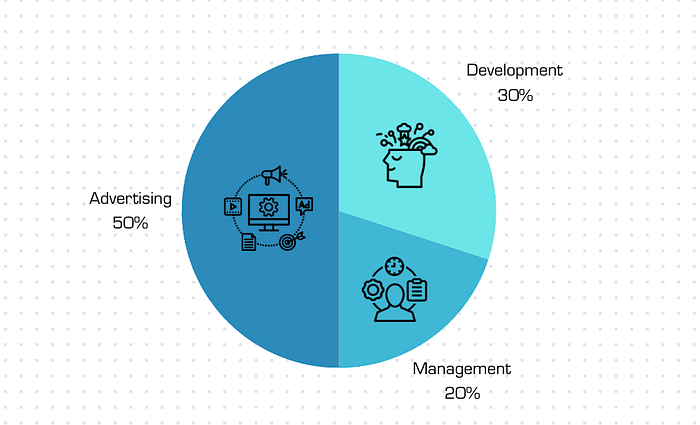
Example: If you’re running a $10,000 campaign, you might allocate $5,000 to ad spend, $3,000 to development costs, and $2,000 to management. These proportions can vary based on your specific goals and resources.
Key Performance Indicators for Marketing Campaigns
We just examined the expenses involved in running a marketing campaign, and if managed correctly, those expenses should yield positive results. When assessing your campaign, there are a few key performance indicators (KPIs) that you should track to understand how things are progressing. These metrics provide deeper insights into what’s working and what needs adjustment, allowing you to optimize your strategy as you move forward. Digital marketing excels in its ability to track attribution, enabling you to see precisely how various touchpoints, such as ads or emails, contribute to your results. This level of granularity is often lacking in traditional marketing methods, making digital campaigns particularly powerful for data-driven decisions.
By understanding key metrics, you’re not just looking at outcomes but uncovering the why behind them. Here are the critical metrics every campaign should monitor:
- CTR (Click-Through Rate): Measures the percentage of users who click on an ad. Example: If 100 users see your ad and 5 click on it, your CTR is 5%.
- Conversion Rate: The percentage of users who complete a desired action. Example: If 200 people visit your landing page and 20 make a purchase, your conversion rate is 10%.
- CPC (Cost Per Click): The amount you pay for each click on your ad. Example: Spending $500 for 1,000 clicks gives a CPC of $0.50.
- ROAS (Return on Ad Spend): Revenue generated per dollar spent. Example: $10,000 in revenue from $2,000 in ad spend yields a ROAS of 5x.
This list of basic KPIs is just a starting point for evaluating your marketing campaign’s success. For a deeper dive into essential marketing metrics, be sure to check out my earlier article on the topic, which provides a comprehensive guide tailored to small businesses.
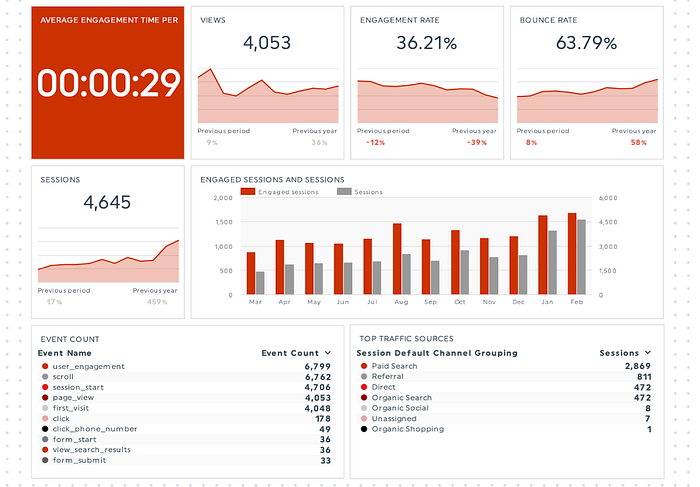
Rules of Thumb for Marketing Campaign KPIs
Understanding your KPIs is essential for monitoring and optimizing your marketing campaign. While the exact targets may vary based on industry, campaign goals, and audience, these general rules of thumb can help you interpret your metrics effectively:
- CTR (Click-Through Rate): A healthy CTR for most digital ad campaigns is around 2–3%. If CTR is low, it could mean your ad copy or visuals aren’t engaging enough. Test new headlines, tweak your targeting, or experiment with different ad formats.
- Conversion Rate: The average conversion rate across industries typically falls between 2–5%. Higher conversion rates (10% or more) are common for highly targeted campaigns, such as retargeting ads. A low conversion rate suggests issues with your landing page, offer, or call to action. Ensure your page loads quickly, is mobile-optimized, and has a clear path to conversion.
- CPC (Cost Per Click): Benchmarks for CPC depend heavily on the platform and industry. On Google Ads, a CPC under $1 is considered low, while industries like legal or finance may see CPCs exceeding $10. Aim to keep CPC in line with your budget and ROI expectations. If CPC is too high, it may indicate you’re competing for overly broad or high-demand keywords. Narrow your targeting or explore less competitive keywords.
- ROAS (Return on Ad Spend): This metric is perhaps one of the most important to track for your campaign. A ROAS of 3x (earning $3 for every $1 spent) is a good baseline for most campaigns. For highly competitive markets, even a 2x ROAS might be acceptable, while niche markets can aim for 5x or more. If ROAS is underperforming, revisit your ad spend allocation. Focus on high-performing channels and reduce budgets for those with low returns.

These benchmarks should guide your ongoing campaign optimizations. Marketing campaigns are iterative processes, and even minor adjustments—such as testing a new image or changing ad placement—can significantly affect results. Remember, these figures aren’t ‘frozen in time.’ They gain importance when monitored over time, revealing trends that assist you in refining your approach. By regularly tracking metrics and adjusting tactics as needed, you’ll be able to make informed decisions that drive meaningful results.
Advanced Forecasting of Campaign Performance
While the previous sections focused on costs and KPIs using descriptive analytics to understand past performance, forecasting takes a step forward into the realm of predictive analytics. Just like any investment — and marketing is indeed an investment — there are no guarantees of future performance. However, by applying well-established analytical models and leveraging years of data from Internet marketing, businesses can create forecasts that help set realistic expectations for campaign outcomes.
Customer behavior often follows patterns of seasonality and trends, such as holiday shopping surges or back-to-school periods, making it possible to anticipate demand and engagement. However, forecasting must also account for external factors, such as competitor actions and changing marketplace conditions, which can and likely will affect your results.
Below are some of the most common marketing campaign forecasting techniques, with examples of how they work, their strengths, and their weaknesses.
- Time Series Analysis relies on historical data to identify patterns and trends over time. For instance, a small business could use ARIMA (AutoRegressive Integrated Moving Average) to predict click-through rates (CTR) for an annual holiday campaign based on past performance during the same timeframe. Time series analysis excels at detecting seasonality and trends, making it particularly effective for recurring events. However, its reliance on historical data means it may not perform well in rapidly changing markets or when unexpected disruptions occur.
- Seasonal Decomposition Models such as Prophet, a tool developed by Meta (Facebook), are ideal for short-term and seasonal forecasting. These models handle missing or inconsistent data effectively and can adapt to sudden shifts in traffic or engagement patterns. For example, a seasonal decomposition model could forecast website traffic for a holiday promotion campaign, even if data from previous years is incomplete. The primary strength of these models lies in their robustness for handling real-world data irregularities. However, they may require technical expertise for implementation and are less intuitive for users unfamiliar with statistical programming. For more information about Prophet, see my previous article about using it to forecast web traffic.
- Leading Indicator Analysis focuses on identifying early signals of campaign success or failure, such as engagement or click-through rates. For instance, an email campaign that achieves an unusually high open rate (e.g., 20% compared to a typical 10%) could be a strong indicator of future conversions. This approach allows marketers to make real-time adjustments based on early performance signals, optimizing results as the campaign progresses. However, it is not always a reliable predictor of ultimate success and works best when combined with other methods.
- Predictive Analytics Models leverage machine learning and statistical techniques to analyze historical data and forecast future outcomes. For example, clustering algorithms like k-means can segment customers by lifetime value to predict which groups are most likely to respond to a retargeting campaign. Predictive analytics is highly effective for identifying high-value customers, optimizing marketing channels, and anticipating product demand. Its primary weakness lies in its dependency on large amounts of high-quality data and computational resources. Without proper implementation, these models can overfit or fail to account for external factors like competitive actions.
- Simulation Models are used to test “what-if” scenarios, allowing businesses to visualize potential outcomes without committing resources upfront. For example, a Monte Carlo simulation could help determine the best budget allocation between Google Ads and Meta Ads by simulating various combinations and their expected returns. Simulations are highly flexible and provide valuable insights into possible campaign outcomes. However, their accuracy depends heavily on the quality of input data and the assumptions made, which may oversimplify complex market dynamics.
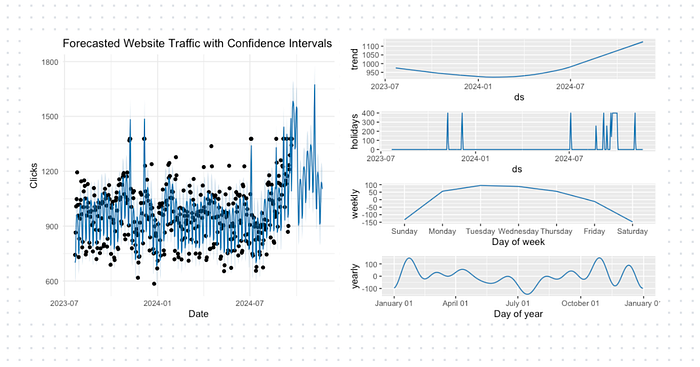
Tips for Effective Forecasting
Business forecasting is both an art and a science. Here are some general tips on how to make your marketing forecasts more effective.
- Leverage Historical Data: Use data from your previous campaigns as a baseline to identify patterns and trends.
- Incorporate Market Insights: Combine quantitative analysis with qualitative insights, such as customer feedback and competitor activity.
- Monitor in Real Time: Adjust forecasts dynamically by tracking performance metrics like CTR, CPC, and ROAS during the campaign. A marketing dashboard can help keep everything together in one location.
- Conduct A/B Testing: Use small-scale tests to validate assumptions and fine-tune models before launching a full-scale campaign.
- Account for Uncertainty: Use tools like Monte Carlo simulations to explore a range of possible outcomes and prepare for variability in results.
Tips and Pitfalls for Marketing Campaign Success
If the middle part of this article felt like diving into a math textbook, don’t worry — we’re about to come back up for air. Campaign forecasting and metrics can be a bit technical (we may have mentioned ARIMA and Monte Carlo like they’re old friends), but the truth is, even the best analytics won’t save a campaign that misses the mark on the basics. Imagine running a perfect simulation to predict ROI, only to realize your ad had a glaring typo or targeted people who’ve never heard of your product. So, let’s zoom out and cover some straightforward, non-technical tips to help your campaigns shine — and a few pitfalls to dodge along the way.
Tips for Marketing Campaign Success
- Clearly Define Your Target Audience: Spend time identifying who you’re trying to reach. Avoid broad targeting, as it leads to wasted ad spend and lower engagement.
- Invest in High-Quality Creatives: Your marketing creatives, the visuals, and copy, should reflect your brand’s look and feel, including consistent colors, fonts, and logos. This builds trust and makes your campaign recognizable.
- Set Realistic Expectations: Pilot campaigns are a great way to test ideas and refine strategies. Avoid overspending on an unproven approach. Avoid overly broad goals like “more sales”.
- Optimize Throughout the Campaign: Monitor metrics like CTR and CPC in real-time, and adjust targeting, messaging, or budgets as needed.
- Use Free or Low-Cost Tools: Platforms like Google Analytics or Canva can help stretch your budget while maintaining quality and insights.
- Experiment with Ad Formats: Don’t assume one size fits all when it comes to ads. Test different formats, such as carousel ads, videos, or single images, to see which resonates most with your audience. Testing ensures you’re investing your budget in the most effective format.
- Execute Remarketing Campaigns: Not every potential customer will convert on their first visit, but that doesn’t mean they’re lost. Remarketing campaigns enable you to re-engage users who have visited your website or interacted with your ads.
Marketing Campaign Pitfalls to Avoid
- Overspending on One Channel: Diversify your ad spend across platforms to avoid over-reliance on a single source.
- Neglecting Analytics: Failing to track performance during the campaign can lead to missed opportunities for improvement. Avoid using a single metric to measure success.
- Relying on Default Settings: Default platform settings often prioritize ease over effectiveness. Customize campaigns to align with your goals.
- Underestimating Time Commitment: Running a campaign takes time and effort, from setup to optimization. Ensure you allocate sufficient resources.
- Neglecting Mobile Optimization: Since most users interact with content on their phones, failing to optimize your ads and landing pages for mobile can be costly. Before launch, always check your campaign materials' appearance and performance on mobile devices.
- Confusing Marketing with Sales: Campaigns aim to generate awareness, leads, and engagement rather than just closing sales. Misaligned expectations can lead to frustration, one of the most common pitfalls to avoid. If your campaign is reaching people but not converting them into sales, focus on the conversion issue, and don’t dismantle the entire campaign. A small adjustment will likely make it successful!
Example Digital Marketing Campaign: A 90-Day Plan
Scenario of Example Campaign:
Imagine a small local business — a boutique bakery — launching a new line of artisanal desserts. The goal of the campaign is to drive 1,500 leads and significantly boost in-store sales over a targeted 90-day period. The bakery has a $7,500 budget, split across three months at $2,500 per month.
Budget Breakdown of Example Campaign:
- Development: $1,500 This covers the creation of visually appealing content, including high-quality photos of the new dessert line, a short promotional video, and professional social media templates. These assets will be used throughout the campaign.
- Advertising: $4,500 ($1,500/month) Allocated across two platforms: $900 for Google Ads and $600 for Meta Ads (Facebook and Instagram) per month to drive traffic and engagement.
- Management: $1,500 ($500/month) This includes internal time for campaign setup, ongoing management, and analytics tracking, as well as subscriptions to tools like Canva for design and Meta Pixel for performance monitoring.
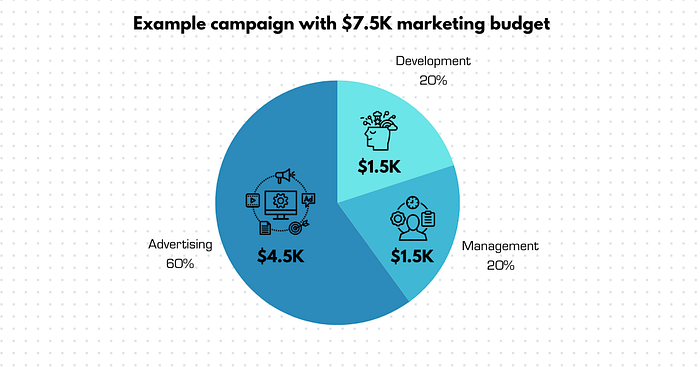
Activities of Example Campaign: The campaign focuses on three primary marketing channels:
- PPC Advertising (Google Ads): Run search ads targeting keywords such as “artisan bakery near me” and “best desserts in [city name].” Allocate $600/month to search ads and $300/month to display ads for retargeting website visitors.
- Social Media Campaigns (Meta Ads): Create visually engaging posts and stories to showcase the new dessert line. Spend $600/month on boosted posts, video ads, and engagement campaigns, including contests to encourage user participation.
- Email Marketing: Use the bakery’s email list to announce the new product line and offer an exclusive in-store discount during the first month. Follow up with automated drip campaigns tailored to leads captured through Google and Meta Ads.
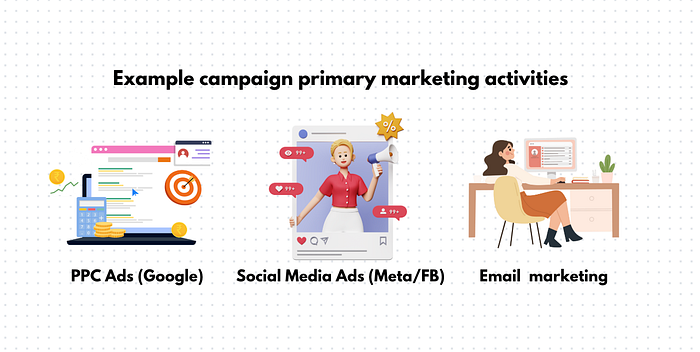
Timeline of Example Campaign:
- Month 1 (Setup and Launch): Focus on creating high-quality visuals, setting up PPC campaigns with targeted keywords, and launching social media promotions. Announce the new desserts via email and encourage customers to visit in-store for an exclusive launch offer.
- Month 2 (Optimization): Monitor campaign performance and test ad variations to improve CTR and engagement. Refine audience targeting and adjust ad budgets based on what’s working best. Continue email drip campaigns and leverage customer feedback for testimonials or user-generated content.
- Month 3 (Scaling): Ramp up successful campaigns with increased ad spending on top-performing channels. Highlight testimonials and reviews in ads to build trust. Conclude the campaign with a final push featuring a limited-time offer, such as a “last chance” discount or exclusive bundle.
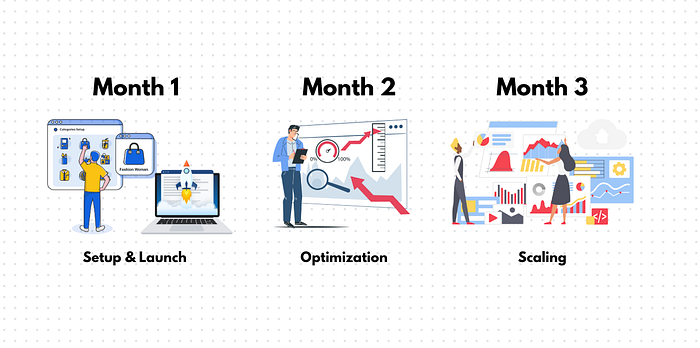
Expected Metrics of Example Campaign:
- Click-Through Rate (CTR): 3% — The PPC campaign is expected to generate a click-through rate of 3%, aligning with 7,500 website visits based on the ad impressions. A strong CTR indicates that the ads are effectively engaging the target audience.
- Cost Per Click (CPC): $0.50 — With a $7,500 advertising budget and 15,000 ad clicks, the campaign targets a cost per click of $0.50. Keeping CPC low while maintaining quality traffic is critical for maximizing ROI.
- Conversion Rate: 10% — The campaign aims to convert 10% of website visitors into in-store purchases, resulting in 750 total conversions. This conversion rate reflects a well-optimized campaign, particularly for targeted or retargeting efforts.
- Return on Ad Spend (ROAS): 3x — The bakery expects to earn $22,500 in revenue, assuming an average customer spend of $30 per visit. This translates to a 3x ROAS, meaning $3 is earned for every $1 spent on advertising.
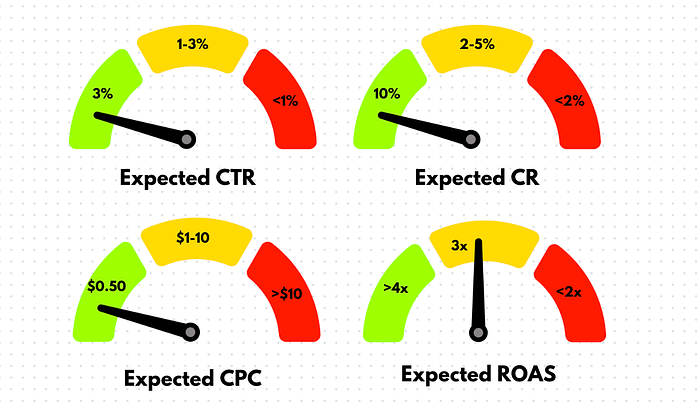
Summary and Conclusion
Marketing campaigns are like planting seeds for your business’s growth. When thoughtfully planned and executed, they yield valuable outcomes like engagement, trust, and long-term success. By concentrating on measurable goals, understanding key metrics, and leveraging forecasting techniques, your campaigns can serve as both a foundation for immediate results and a guide for refining your overall marketing strategy. Start small — perhaps a 90-day campaign — to test ideas and discover what resonates with your audience. Treat your campaign as an investment where tracking metrics and analyzing data help it thrive, much like nurturing the roots of a tree ensures healthy growth.
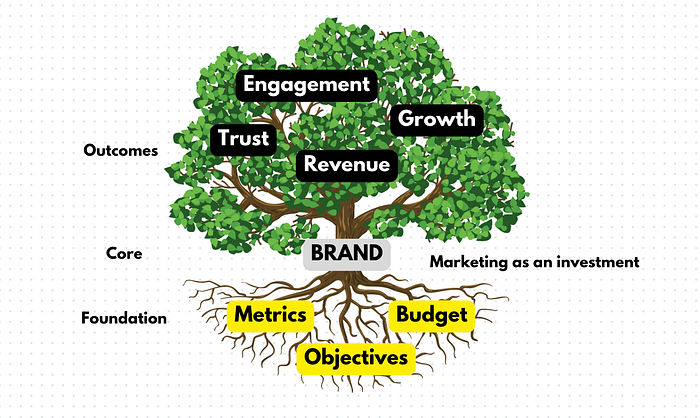
The best time to begin is now. Set clear objectives, allocate a realistic budget, and select channels that align with your goals. As you plan, allow the numbers to guide your decisions. Use metrics such as click-through rate (CTR), cost-per-click (CPC), conversion rates, and return on ad spend (ROAS) to assess your progress and fine-tune your approach. Campaigns are as much about learning as they are about achieving results. They can offer valuable insights and feedback that influence your future strategies. With thoughtful planning and ongoing effort, your campaigns will generate the momentum and engagement needed to drive your business toward success in 2025 and beyond.